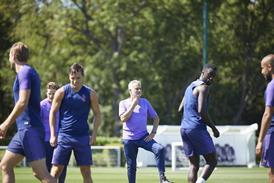Indie chief reveals international collaboration behind latest bluechip natural history series
The managing director of Bristol’s Offspring Films has laid out the benefits of bringing together international partners for her latest bluechip natural history series.

Isla Robertson sat down with Broadcast following last week’s announcement of the 4 x 60-minute An Hour On Earth for BBC1 and PBS, with Fremantle as distributor. The programme will use a one-shot narrative technique to reveal times of the day when different landscapes suddenly come alive with wildlife activity.
Robertson said while international collaboration was necessary to fund the bluechip project, it was also a “huge” opportunity to benefit from both UK and US expertise.
“It’s great to bring together two collaborators who are familiar with each other as co-production partners but not necessarily familiar in working together through an independent,” she said.
“The reality is it’s the new reality. There is obviously more work in pulling together multiple co-producers to deliver different versions of programming but this is just something we must accept because the financial contributions from the PSBs aren’t what they used to be.
“You can also reap the benefits of having different editorial partners feeding in. It’s a superpower in the editorial and a huge benefit to production.”
While each broadcaster has editorial control over their own versions of the title, she said it helps that the two are “broadly aligned editorially” – with local voiceovers being the main point of difference, minimising the need for a huge amount of additional filming.
Robertson said independents like her can also help broadcasters solve a particular shared challenge as the industry emerges from a natural history boom; they need to find projects that make fatigued audiences experience stories in new ways.
“PBS is working with the BBC on a number of natural history projects but they are also looking at working with independents to try and get that distinct flavour into their raft of programming,” she said.
Equally, she believes distributors are struggling to acquire high-end premium natural history series because so many series are being commissioned by the streamers who hold on to the rights.
“Having a project like this that is well-funded, has two major international partners behind it and has the rest of the global rights available was music to Fremantle’s ears,” she said.
Robertson pointed out that in some ways, the rise of international collaborations is a return to the “old normal” - the pre-streaming age during which bluechip PSB projects like Planet Earth had to have international collaborations to achieve the high budgets.
“As producers that opportunity has always been there and it’s an exciting time to be able to recognise that opportunity all over again. It will be interesting to see more people will be going out to Mipcom looking for international partnerships,” she added.
PBS senior director of programming and development Diana El-Osta said: “We’re thrilled to be partnering with the stellar creatives at Offspring on this innovative series. An Hour on Earth will present our viewers with a never-before-seen view of the natural world during its most important yet ephemeral moments.”
Immersive storytelling
Robertson detailed exactly how her project achieves its distinctive flavour, with the overarching ambition of the one-shot narrative being to engage the viewer more fully in the action on screen.
“Natural history can feel quite distant, going from one location to the next without truly immersing viewer in that location,” she said.
“We wanted to tighten the lens on a specific place at a specific time. It is actually sort of anti-the big global natural history landmark to close that lens and point at specific place and time, but it’s a real opportunity for the viewer to feel genuinely embedded in that landscape.”

The technology used to achieve the one-shot narrative technique includes POV drones and Working with hyperlapse – moving time lapse which can be stitched together in post production to create a seamless shot.
Robertson said: “For us, it is not enough just to say you’re using new technology – it is crucial to think about what that can deliver in terms of the storytelling.
































No comments yet